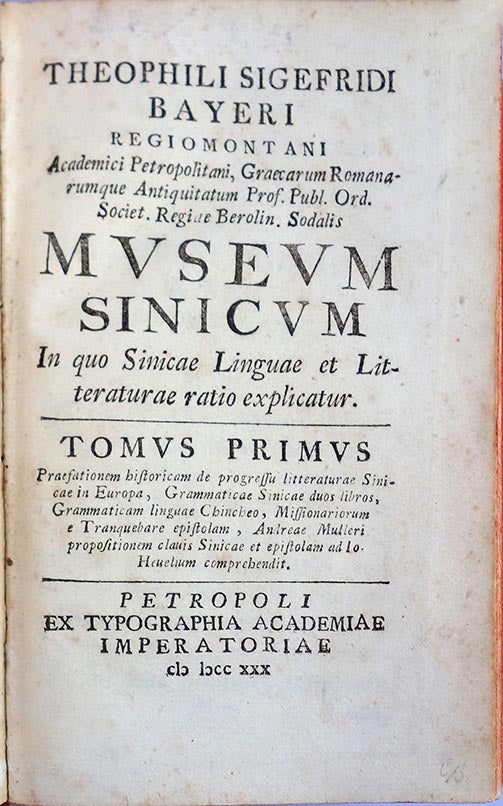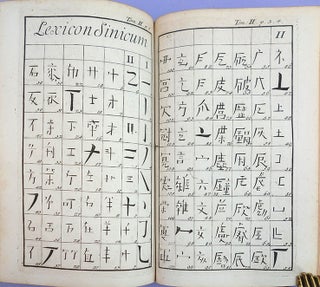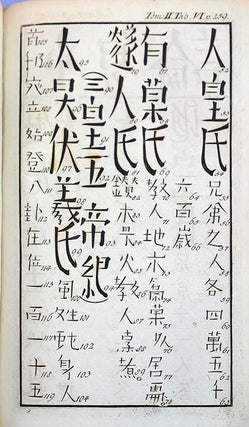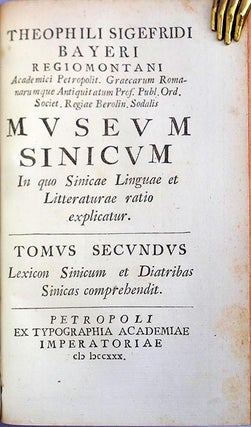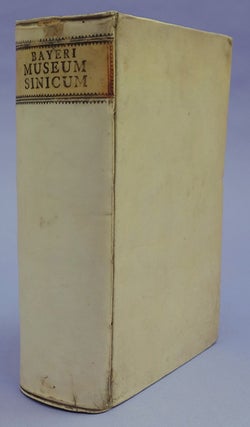Museum sinicum in quo Sinicae linguae et litteraturae ratio explicatur
Publisher Information: St. Petersburg: Typographia Academiae Imperatoriae, 1730.
The First Book on the Chinese Language Published in Europe
Bayer, Theophilus [Gottlieb] Siegfried (1694-1738). Museum sinicum in quo sinicae linguae et litteraturae ratio explicatur. 2 vols. in 1, 8vo. [22], 145, [1], 190; [2], 372, [2, including errata]pp. 23 numbered plates plus 52 full-page text engravings. St. Petersburg: Ex typographia Academiae Imperatoriae, 1730. 198 x 123 mm. Old vellum, title stamped on spine. Minor offsetting from plates, but fine otherwise. Embossed stamp of the British and Foreign Bible Society on front endpaper.
First Edition of the first book on the Chinese language published in Europe. Bayer, a classical scholar, was professor of Greek and Roman antiquities at St. Petersburg’s Academy of Sciences between 1726 and 1737. At the age of nineteen he was “overwhelmed with a desire to learn Chinese” and spent the next seventeen years studying and collecting everything he could find relating to the language with the intent of “[making] up some kind of dictionary and some introduction to the rules of the Chinese language and to Chinese literature” (quoted in Spence, Chinese Roundabout: Essays in History and Culture, p. 3). This was an extremely difficult task, as the Jesuits, who were the first Europeans to gain a foothold in China, had a quasi-monopoly on Sino-European relations and thus had a proprietary interest in keeping information about the Chinese language to themselves. “In the course of time, however, a few Jesuits visiting Europe came to give away some bits of the secret, and two or three copies of handwritten missionaries’ dictionaries had found their way into great libraries” (Lundbaek, p. 2). Bayer made use of what information he could find to compile his Museum sinicum, which included not only his attempt at a Chinese dictionary and grammar, but a 145-page introduction containing a history of Western Chinese studies up to the time of writing.
"There are two things that need to be said [about the Museum sinicum]: It was not possible to learn to speak or read Chinese from Bayer’s book; secondly, Bayer was perfectly and painfully aware of that fact and states it many times in his book.
"Why then publish it? Bayer felt, and he was supported in this feeling by his old friend the great Lacroze in Berlin, as well as by his new friend Theophanes, the learned archbishop of Novgorod, that it was his duty to do so. There were no books about the Chinese language on the market. He had had access to information about that language because he had happened to study in the Royal Library in Berlin, where some handwritten material about the Chinese language was kept. It was not very much and in spite of all his endeavors, Bayer certainly did not come to “know Chinese.” But he felt that he simply had to arrange the information he had gathered together, to collect his thoughts and sit down and write a text that could be printed and published, thus making it possible for others to go on with his work" (Lundbaek, p. 5).
Lundbaek, T. S. Bayer (1694-1738): Pioneer Sinologist, pp. 1-7.
Book Id: 43781Price: $12,000.00

